On the Road is a weekday feature spotlighting reader photo submissions.
From the exotic to the familiar, whether you’re traveling or in your own backyard, we would love to see the world through your eyes.
frosty
This park is managed as more of a preserve than many others. There are strict rules about moving (and Heaven forbid taking) any objects from the park so visitors are required to stay on the short trails at several turnoffs and overlooks and not venture into other parkland. Because of this, most of the park, and not just the high points, can be seen in a day. The south visitor center has a short loop trail with some of the largest logs in the park. Most of the turnouts were worth the stop, especially Long Logs, Crystal Forest, and Blue Mesa Trails
The petrified logs are remnants of extinct conifers from a Triassic rainforest, 225 million years ago, when Arizona was part of the single continent of Pangea and was just north of the equator. Rivers flooded and moved trees, and logs and sediment covered them. Groundwater rich in silica and minerals replaced the organic elements. Subsequently, continents moved, land uplifted, climate changed, and erosion exposed the petrified trees.
Most of the National Park is in the Painted Desert, a high desert with elevations around 5,000 feet. The most scenic part is north of I-40. We stopped at several overlooks, along with other turnouts and trails off of the park road. The colors come from iron and manganese, the same elements that colored the petrified wood.
This area is the only part of the park where visitors are permitted to leave roads and graded trails. It’s a wilderness, with no defined trail other than the switchbacks to get down off the rim to the desert floor.
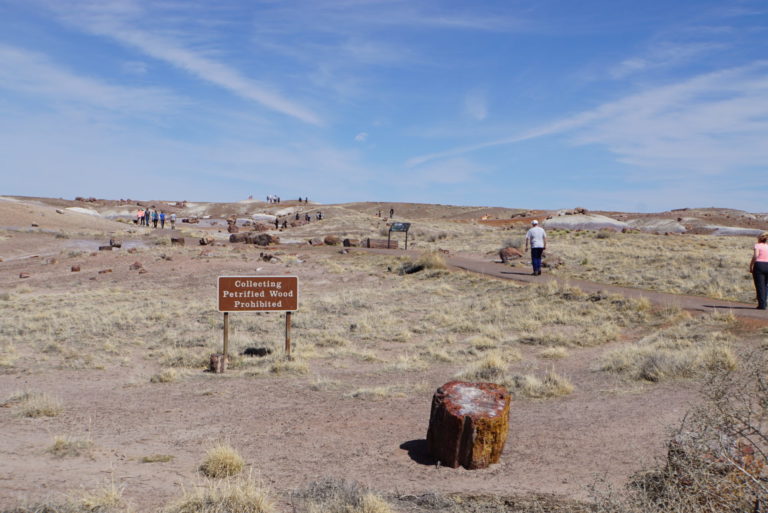
Crystal Forest Trailhead. All the trails were either paved or gravel.
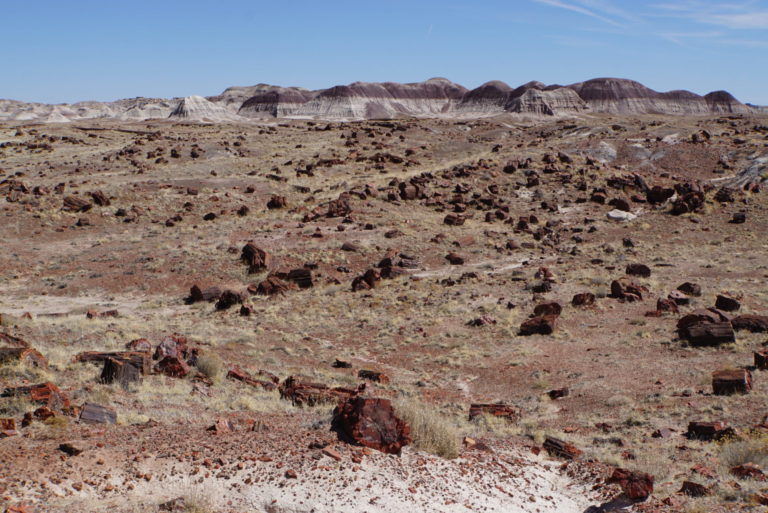
There are locations in the park where it seems like the landscape is littered with petrified logs. This was one of them.
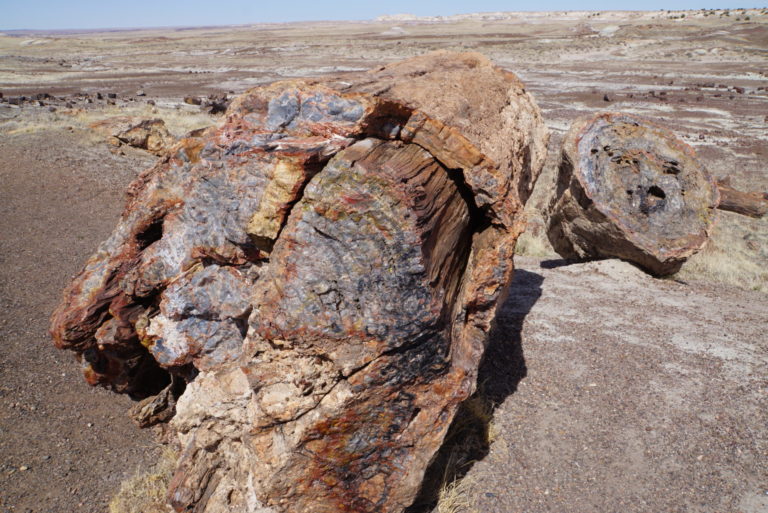
Some of the petrified logs looked incredibly like trees. The difference between heartwood and bark is clear on this one.
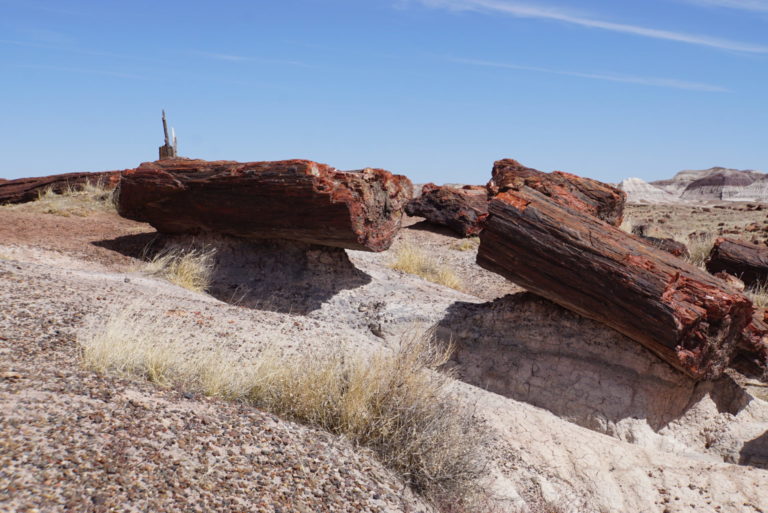
The petrified wood is much harder than the sedimentary rock it lies on. Wind and water will erode the underlying rock everywhere except directly under the “wood”.
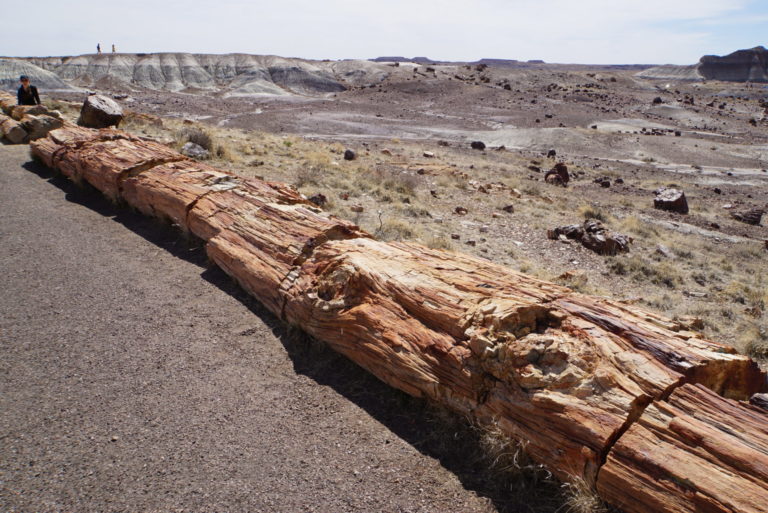
These pieces look like they were chainsawed, but the even perpendicular breaks are a function of how the mineral crystals break.
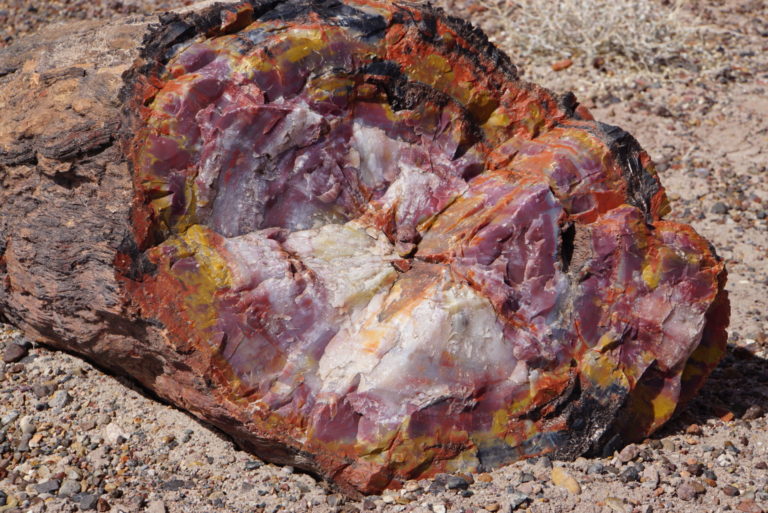
As the trees became mineralized, trace elements changed the quartz from white to several different colors. This was one of the more colorful ones.
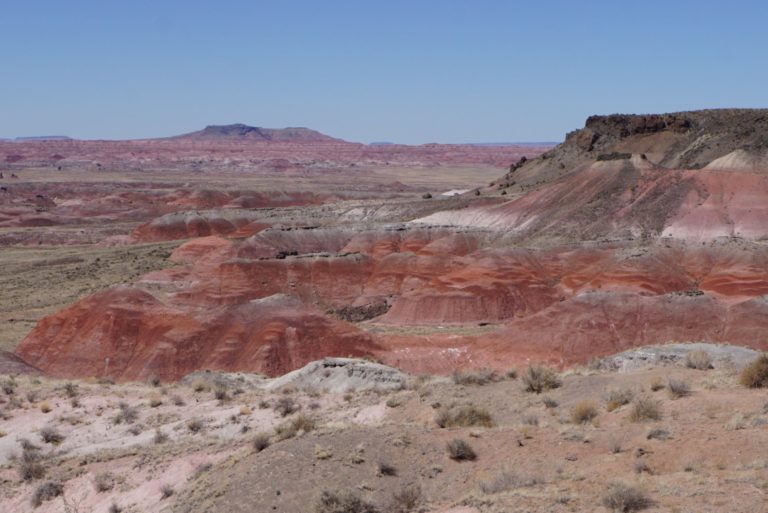
Painted Desert from one of the overlooks.
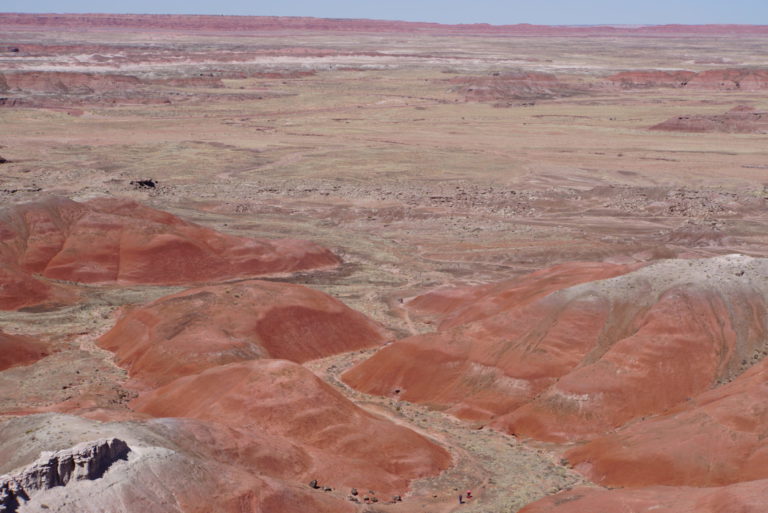
Wilderness Trail, first step to the backcountry.

OzarkHillbilly
Whew, had me worried for a second or 3. Took my sons to Petrified Forest/Painted Desert back in the late ’90s. I was very surprised when I asked about trails and the ranger at the desk told me there were none, that a person could go wherever they felt like. I was even more surprised when I asked about permits and was told there were none, a person could go whenever they liked.
Guess what we did the next day?
John Revolta
Wow! Very cool.
raven
sweet
HeartlandLiberal
Excellent pics portraying a natural wonder. I have to admit, I would LOVE to have a big chunk of petrified wood, especially the colorful one. Just sayin’.
Quinerly
Great park. Spent my birthday there in 2017. Doggie Poco loved it. Very dog friendly… And they can pee pretty much anywhere. ?
JoJo las Orejas and I will be there right after Christmas if our traveling plan holds.
Great pics! Thanks.
Laura Too
Wow, the long one that looks cut is really cool! Thanks for the stories.
cope
I’ve never been there so thank you for sharing your visit with us. Did they have a display of samples or pictures of samples that people took and then returned because they felt horribly guilty or suffered some run of bad luck? I have seen displays like that at other places though usually they are related to pieces of pottery or arrowheads.
When I was doing oil field work in the ’70s and ’80s there were places where I could wander through the local geology during downtime on the rig. I was always on the lookout for petrified wood and other fossils. Where it was permitted (usually BLM land), I managed to collect some beautiful pieces. Sadly, almost my entire lifetime collection of rocks, minerals, fossils and petrified wood was stolen.
Anyway, thanks again.
Elma
I was there on a family road trip through the Southwest MANY years ago. It was a camping trip, because that is the only way our big family could afford to travel. I remember it was very hot until the sun went down and then it was very cold.
arrieve
A place I always wanted to visit! Thank you for the wonderful pictures.
We drove from the Bay Area to the Texas Panhandle when I was five, and I remember crying in the car and begging my father to go the Painted Desert. He said no, and I still haven’t been there.
Benw
Wow, cool pics. Another park I need to visit in person
frosty
@HeartlandLiberal: Lots of places in the area sell pieces of petrified wood. Apparently not all if it is inside the park.
piratedan
in the visitor centers they do have some samples of the petrified wood on display and educational materials on how the mineral replacement took place. The park changes with the time of day, some areas may looked washed out just after sunrise, sparkle in the afternoon and vice versa. The Painted Desert looks like one of those sand terrariums that have the different colored sand displays, here’s its not artificial at all. The angle of the sun simply changes how everything looks.
If you’re in the market for these kinds of items, there are a couple of places outside the US 180 entrance that sell items. My favorite is Jim Gray’s, located just outside of Holbrook (the nearest town with living inhabitants), good selection for small collectors and folks that want something more substantial, be it mineral/gemstone based or something fossilized. Word of caution, the big stuff is NOT cheap and it’s heavy as hell
Visit here every year as the spouse participates in their “Pedal The Petrified” event which is a bike ride sponsored thru the park benefitting the local community colleges. As far as I know, it’s the only bike tour allowed in a US National Park, spouse swears by it because it allows you to truly enjoy the beauty of the park as you get to watch it evolve more slowly before your eyes.
J R in WV
I have seen heavy tractor-trailer flat bed trucks loaded up with “timber” from ranches near the park. HEavy equipment used to excavate and handle those logs. They pay by the pound/ton after being weighed empty and full at near-by truck-stops. It is unfortunately exactly like strip-mining for coal, only lower in carbon release.
I’ve also seen wonderful giant tables made of slabs 4 or 5 inches thick, sawn from giant petrified tree logs — tables 15 feet long and 6 feet wide! You would need a really big fork lift to move those tables around!
I have a number of different slices of agate logs, the mineral the petrified forest logs are composed of, in white, red, yellow with different small patches of other colors, green, blue, brown and tan. Our last visit to the petrified forest area I was driving the late F-350 and bought a chunk of petrified wood on a pallet, about 450 lbs. My tractor has a fork lift attachment for the loader bucket which is how I unloaded it. Someday I intend to get a slice of clear glass to use as a table with the log underneath. So far it just sits on a now-decrepit pallet outside the house.
It is a bleak but beautiful scene, the painted desert!
Emerald
Long dead thread but I have to post here anyway. My sister and I went to the Petrified Forest last year and found it fascinating. The Crystal Forest is the only accessible trail I could find, but I was able to navigate it (warning: steep in a few places so have somebody holding onto the back of your chair). A fantastic memory. Much of the rest of the park is easily viewed from a car.
So thanks for posting this!
frosty
@cope:
There apparently is a pile of pieces that people took then mailed back. NPS can’t put them back in the field because it wouldn’t be correct archaeologically. I meant to ask about it and forgot.
RW Force
Tons of the logs were hauled away to make industrial abrasives. When a railroad spur and an abrasives factory were planned for the site in 1906, Teddy Roosevelt protected it as a national monument.
frosty
@arrieve: That’s a shame because you can pull off the highway, see the overlooks in an hour and get back on the road. My family did it on a cross-country trip when I was a kid The highway would have been Route 66 back then.